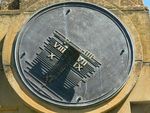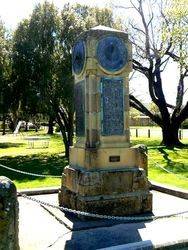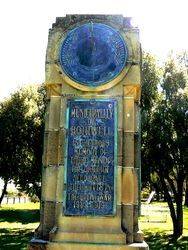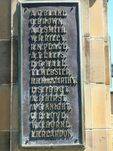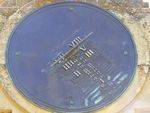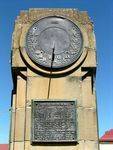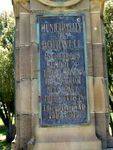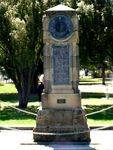
Bothwell War MemorialPrint Page 
The Bothwell War Memorial is a sundial and it lists 29 names of those who died in World War One.
At Bothwell yesterday afternoon, in fine weather, the Administrator, Sir Herbert Nicholls, unveiled the war memorial erected by the people of the district. The memorial is a very fine one the base being constructed of Victorian bluestone, and the remainder of granite. The inscription reads as follows: "Municipality of Bothwell. In glorious memory of those men of the district who gave their lives in the Great War, 1914-1918."
The names of the fallen are on bronze panels, cast in Brisbane, and designed by the Queensland Surveyor's Office. Each of the sun dials, which face north, south, east, and west, is two feet in diameter. A plate showing the difference between standard and mean time has been fixed on the north side. The design has been adapted from sundials of ancient Greece, and is believed to be the only one of its kind in Australia. The memorial itself was designed by Messrs. Walker and Johnston, of Hobart, and was also made in Brisbane. Altogether the memorial is a fine one of which the people of Bothwell should be proud.
The Mercury (Hobart), 29th March 1923.
THE SUNDIALS.
(From the Brisbane "Courier.")
For a sunny country like Australia the rarity of sundials is remarkable, especially in the country, where they would be of practical use, accuracy to a minute or so not being essential. Possibly this scarcity is due rather to ignorance of the sundial's advantages than to want of interest. An excellent example of the application of the sun-dial is to be seen in the window of the premises lately occupied by the Australian Hardware Company, in Queen street, where four-vertical sundials, intended for the four faces of a soldiers' memorial which is being erected in the town of Bothwell, Tasmania, are on view.
It is something of a compliment to Queensland that the sundials for this memorial were designed and executed in Brisbane. Plans for the dials were not procurable in the south, but the tenderers were supplied with working drawings by the Queensland Surveyor General's office, the calculations for the given latitude of Bothwell being also compiled by the staff. The whole work ,therefore, is a local production, and is not only a technical masterpiece, but is an instructive curiosity of educational value and of practical utility. Each of the dials is of bronze, and is 2ft in diameter. The graduations of the hours and their subdivisions are shown by raised lines, with numbering in conformity with them.
Although all the dials differ from one another, those for the north and south faces of the memorial are constructed essentially on the same principle, and similarly the east and west dials are generally counterparts of one another. The north dial appears to be of greater utility than any of the others, for, theoretically it will be illuminated for 12 hours each day during the six months of the year that the sun is south of the Equator, and during the remainder of the year for the whole time that the sun is above the horizon. In mid winter at Bothwell the sun rises at about 7 45 am, and sets at 4 40 pm, the period of daylight being less than nine hours. The south dial will be usable only during the early afternoon and evening hours between September 22 and March 22 in each year, when the sun is south of the true east point. The east dial will be under the sun's influence daily from sunrise until about 1120, apparent time, this being equivalent to 1146 am standard time. In February, and 11.16 am in November. The west dial will be usable from 12 40pm apparent time until sunset.
A table of corrections combining the effect of the equation of time and the difference between standard and mean time has been prepared, also in metal, and will be affixed in a convenient position. It is suitable for the whole set of dials. The art of dialling at one time exercised a fascinating influence over the ancient Greeks, and some of their architectural and monumental works were embellished by dials of elaborate and often fantastic design. The adaptation of the Grecian idea in connection with the Bothwell memorial is said to be the first instance of the kind in Australia . The memorial was designed by Messrs. Walker and Johnston, architects, of Hobart, and they entrusted the execution to the Gunderson Manufacturing Company, of Edward street, Brisbane, who have just completed the work, and are giving Brisbane residents an opportunity of seeing the dials before shipping them to Tasmania.
The Mercury. Hobart, Tasmania Thursday 15 February 1923
Note : the “Tasmanian War Memorials Data Base” , compiled by Fred Thornett which is located at the State Library of Tasmania, contains a comprehensive listing of the names on this monument.
Location
| Address: | Patrick Street, Bothwell, 7030 |
|---|---|
| State: | TAS |
| Area: | AUS |
| GPS Coordinates: | Lat: -42.384035 Long: 147.007294 Note: GPS Coordinates are approximate. |
Details
| Monument Type: | Monument |
|---|---|
| Monument Theme: | Conflict |
| Sub-Theme: | WW1 |
| Actual Event Start Date: | 04-August-1914 |
| Actual Event End Date: | 28-June-1919 |
| Designer: | Walker & Johnstone (Hobart, TAS), Queensland Surveyors Office (panels) |
| Monument Manufacturer: | Gunderson Manufacturing Company (Brisbane, QLD) |
Dedication
Municipality of Bothwell
In glorious memory of those men of the District who gave their lives in the Great War 1914 - 1918
[ Names ]



